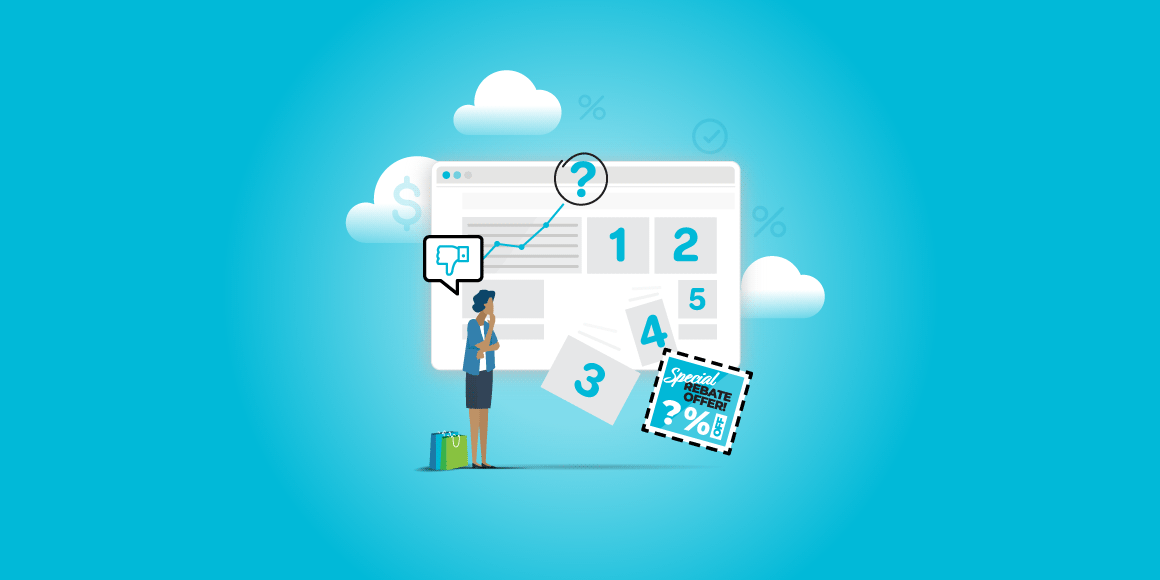Mergers and acquisitions promise the ability to unlock value through scale and new markets. They also deliver a long tail of operational puzzles, and the integration of various incentive programs—especially consumer rebates—sit near the top of that list.
It’s common for a parent company to oversee a patchwork of brands as they acquire smaller companies. The challenge is that each of these more niche businesses likely has its own rebate rules, promotions, timelines, and data to collect. As a result, what may have worked fine in isolation and on a smaller scale now becomes complicated or ineffective when viewed from the new corporate perspective.
That leads to the central question:
Do you let each brand continue its rebate program independently, preserving local momentum and customer familiarity, or do you consolidate under a single, unified strategy and platform?
The honest answer is that both paths have merit—and costs. The art is in assessing how each of these puzzle pieces fits together into the overarching corporate strategy, and managing this change so that it drives value instead of disruption.
The Different Approaches a Parent Company Can Take
Approach #1: Maintain the Status Quo
Keeping programs as-is is the simplest short-term move. Subsidiaries keep running their rebate promotions without interruption. High-performing programs continue to build on their success. And the parent company avoids immediate change-management fatigue. For sales teams accustomed to a particular cadence (say, a seasonal “buy-and-try” with a specific claims flow) this continuity protects revenue while the dust settles.
However, maintaining the status quo is often accompanied by hidden liabilities. Underperforming programs will persist, detracting from overall results. Strategies that once fit a stand-alone brand may now also conflict with corporate positioning, creating internal friction and external confusion.
Oversight becomes a spreadsheet-and-email marathon. Managing so many disparate programs leads to a drain on resources, while also introducing the possibility of compliance gaps and manual errors. Will you have a single Source of Truth for all of these programs? Where will their data be kept? Institutional knowledge of all of these programs will need to be extensive, putting a further strain on program margins and potential ROI.
Finally, the customer experience may lack consistency. A consumer of one brand may sail through a modern, mobile-first claim, while another is asked to print forms and mail UPCs. Over time, those differences erode brand trust and make it harder to report, optimize, or scale.
Pros:
- Minimal short-term disruption to sales and operations.
- High-performing programs keep their momentum and local market fit.
- Faster post-close execution—no immediate platform migrations or retraining.
- Lower initial change-management burden for brand and field teams.
Cons:
- Underperforming programs are more difficult to weed out, putting a drag on program ROI and making it more difficult to sell the benefits of these programs to management.
- Fragmented strategies can conflict with parent brand positioning and goals, leading to inefficiencies.
- Oversight becomes manual, error-prone, and resource intensive (multiple vendors, formats, and KPIs).
- Widely varying customer experiences can erode trust and create upstream brand confusion.
- Harder to get clean, comparable data for optimization and executive reporting.
Approach #2: Consolidate Strategy Across Brands
On the other hand, a consolidation play aligns consumer rebate programs to the parent company’s overarching objectives. It helps maintain uniformity and consistency regardless of brand. With a centralized strategy, you have the opportunity to accumulate large, value-additive datasets. This, in turn, allows you to prune low-ROI promotions and optimize inefficient rules structures.
Assuming the parent company has an automated rebate management system already up and running, you can apply this automation to each new program acquisition. This can streamline operations, including eligibility checks, duplicate-claim detection, digital wallets, and/or real-time dashboards. The customer experience improves because the interface, timelines, and communications are familiar across the portfolio. On the backend, the program management lift remains reasonable, even at scale.
Of course, unifying multiple rebate programs under one platform can bring some headaches as well as synergies. Consolidation isn’t just a software decision; it’s a change-management undertaking. It requires deep partnerships and buy-in from each subsidiary. This change takes time to harmonize data models and train staff who have to learn new workflows.
In addition, not every legacy program will map neatly to the new standards, and turning off a familiar offer, even a suboptimal one, can provoke internal resistance. The work is worth it, but only when sequenced thoughtfully and tied to clear financial and customer outcomes.
Pros
- Stronger brand alignment with consistent messaging across all subsidiaries.
- Ability to curate programs and promotions, with a focus on maximizing ROI at scale.
- Unified interface provides a smoother, consistent customer experience.
- Centralization makes it easier to integrate automation across offerings and reduce manual effort.
Cons
- Requires upfront planning, data harmonization, and downstream collaboration.
- Time and resources needed for platform alignment and staff retraining.
- Legacy promotions may need to be reviewed and revised to meet new organizational objectives, standards, and timelines.
- Cutting or changing familiar offers can trigger internal resistance.
Finding the Best Path Forward
The truth is unavoidable: alignment is required no matter which path you choose. Even if you maintain the status quo, you’ll need governance to set budgets and ensure compliance. Key stakeholders at the parent company level will still want reporting and data to justify continuing rebate program spend, regardless of operations.
In-house teams can do this for a brand or two, but the resource strain grows with each acquisition—more claims to validate, more vendors to manage, more audits to pass.
That’s why the most effective post-M&A approach borrows from both models. Preserve what works locally while building an enterprise framework that can scale. In practice, this means implementing a rebate management platform that is flexible enough to let subsidiaries operate within brand-specific guardrails, but standardized enough to capitalize on the synergies that come with being part of a bigger organization.
Think of it as a chassis-and-body model: the chassis (platform, data model, security, analytics) is common; the body (offer mix, branding, seasonal cadence) can vary by brand. Ultimately, this sort of balanced platform should do four things well:
- First, it should let you configure program rules centrally—eligibility, one-per-household limits, receipt/serial validation—without rewriting code for each brand.
- Second, it must automate routine work: ingesting claims, detecting duplicates or suspicious patterns, applying tax and escheat rules, and issuing payments through multiple methods while maintaining audit trails.
- Third, it should provide real-time analytics across the entire portfolio, so you can see which offers move the needle, where breakage or fraud creeps in, and how customer satisfaction compares by brand or channel.
- Finally, it needs to integrate cleanly with your systems (CRM, ERP, e-commerce, and marketing automation) so data flows both ways and performance is visible in the same places your leaders already look.
Other Considerations
As you begin to decide how best to manage your growing portfolio of rebate promotions, we want to highlight a few other key elements worth considering:
Governance
Strong corporate governance is the companion to technology. Create a lightweight, holistic framework that establishes who approves offers, which KPIs matter, and how optimization occurs.
Instead of dictating every detail, offer a menu of standardized offer types—purchase-based, bundle, trade-in, loyalty accelerators—with clear parameters. Brands can choose from that menu and add their local flavor (creative, partners, seasonal timing), but the underlying structure stays consistent. This approach reduces operational friction and still gives teams the room they need to win in their markets.
Sequencing
Sequencing matters. Start with a diagnostic that scores each program on value and risk: ROI, redemption quality, customer NPS, data completeness, and operational effort. Use that scorecard to identify three quick areas for improvement—often a high-volume brand with duplicative processes, a program with chronic customer complaints, or a promotion that leaks margin due to poor eligibility controls.
Next, migrate those to the new platform first to prove value, capture savings, and build momentum. At the same time, define shared KPIs (e.g., cost per claimed rebate, time-to-fulfillment, fraud/misuse rate, and incremental revenue lift) so success is measurable and comparable.
Communication
Communication will make or break adoption. For internal teams, frame consolidation as a capacity unlock: less manual validation + fewer vendor tickets = more bandwidth.
For customers, underline the improved experience—things like faster payouts and greater status visibility are examples of low-hanging fruit. This will make transition feels like an upgrade rather than a disruption. And for leadership, tie milestones to financial outcomes: reduced leakage and lower operating costs per dollar of rebate issued.
Analytics
Finally, treat data analytics as a flywheel, not a report. With real-time data, you can take a whole host of actions, such as A/B test submission flows, personalize reminders, and payout options tailored by customer preference. You can also pressure-test risks as you grow—for example, how will geography expansions or higher-value offers affect the promotion? Over time, this loop turns the complexity of multiple brands into an advantage: you can learn in one segment and deploy best practices across all.
Conclusion: Turning Complexity into Competitive Advantage
M&A will always introduce complexity to incentive program management, and consumer rebates in particular. Maintaining the status quo can feel easier in the near term, but can create headaches and missed opportunities as time goes on. Consolidation, on the other, can be an up-front challenge, but with the right strategy it can become a long-term engine for consistency and efficiency.
Most winners choose a smart middle path: preserve high-performing elements that customers love, retire what doesn’t serve the new strategy, and align everything on a flexible platform backed by clear governance. Assisted by automation and enhanced data analytics, these rebate promotions can thus become the value-adds they were originally designed to be.
Do that, and the “M&A dilemma” of rebates becomes a synergistic asset that can be more readily sold to stakeholders, and more easily managed by you and your organization.






